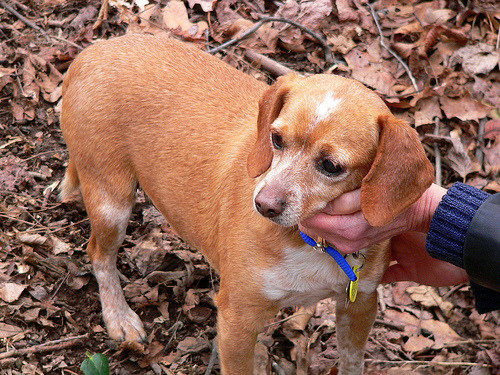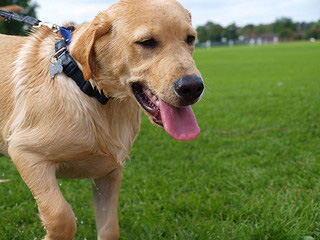Dog Behaviour Part 2: Tackling Specific Problems
17/03/2014
In Part 2 I’ll be addressing some of the specific behavioural problems that dog owners find themselves tackling. These problems may be more common in rescue dogs or dogs that have been re-homed, or they may have started after a dog has been through a distressing experience or they may be problems that came about through inadequate socialising as a puppy.
In Part 1, I expressed the opinion that it’s a lot easier to engender good behaviour in a young dog, rather than trying to rectify problems in an older one. Whilst it isn’t impossible to teach an old dog new tricks, it is a harder job, requiring a lot of patience and awareness. That’s because, whilst they may learn new behaviours well, in times of distress they may revert to the ones they learnt as puppies because these are more instinctive. Owners of older dogs and rescue dogs will need more vigilance to avoid situations that may trigger these reactions and the behaviour associated with them. They will need introducing to these trigger situations very gradually with plenty of patience and rewards when they do well. Socialising does not end with the dog breeder. It is something that continues in the dog’s new home and throughout their lives.
As with the basic training it is important to remember some crucial things before you start tackling a dog’s behaviour:
- Consistency – Make sure all family members and frequent visitors to the house are aware of the methods being used.
- Rewards – Reward positive behaviour instantly with small amounts of food, a little treat, a toy or affection.
- Exercise – Ensuring your dog gets plenty of fresh air, physical exercise and games that provide mental stimulation can have a huge affect on their behaviour.
- Diet – A nutritionally-balanced, good quality dog food, such as Dr John Platinum or Heritage Adult, offered at the same times each day will nourish and satisfy your dog. If you are using food as a reward, you can set aside an amount of their daily portion to use for rewards to avoid over-feeding. Remember to feed to condition to keep your dog in great shape.
- Rest – All dogs, but especially those with behavioural problems, need a safe place where they can go for peace and quiet when they are tired or distressed. Make sure other family members or guests, in particularly children, know to leave the dog alone for a while if they are resting.
It is also important to find the underlying cause of unwanted behaviour in a dog before you start to address it. Here are some possible causes:
- Breed traits – It is of vital importance before you get a dog to carefully consider which breed will best suit your homelife and your lifestyle. If you work full time and don’t enjoy the outdoors much, then getting a big dog that needs lots of exercise will most certainly cause a huge amount of problems for both of you. Some dogs are bred to retain sought-after attributes of the breed. Border collies are highly intelligent and have boundless energy, terriers are boisterous, labradors and other gun dogs are great at retrieving and they all need these skills exercising in every day life to prevent boredom and behaviour problems setting in.
- Boredom and lack of exercise – It isn’t just the breeds mentioned above that get bored quickly. As previously stated, all dogs need exercise. The amount varies depending on the breed and size of dog, but any dog will benefit from the fresh air and a good run around outside. Mental stimulation is important too. A bored dog will fall back on disruptive behaviour to entertain themselves.
- Anxiety – A dog that has been through stressful situations, such as leaving its mother too soon, being abused or neglected, or suffering an accident of some sort, will be anxious and distressed. Anxiety can be displayed in many ways; howling and barking, destroying the home, aggression and losing bladder or bowel control. An anxious dog will need to be dealt with gently and patiently to avoid exacerbating the problem.
- Lack of socialising and training – If a puppy or young dog has missed out on socialising or training has been missing in a particular area, then behavioural problems can arise as a result.
Let’s take a look at some specific problems:
- Car Travel – Considering a puppy’s first trip in the car is often when it is taken from its mother, which is naturally a distressing time for them, and subsequent trips tend to be to the veterinary surgery, it’s no wonder that many dogs end up with a fear of car travel. This problem is simply remedied with a few games and by creating short positive experiences around the car where the dog can be rewarded for calm, non-disruptive behaviour. One such game could involve opening all the doors of the car so that the dog sees the car as a tunnel, rather than a closed environment. Holding the dog’s lead and tempting them with a treat you can play a game where they follow you on different routes across the back seats or from a back door through to the boot. From here you can gradually encourage the dog to stay in the car and progress to shutting the doors before attempting a very short trip somewhere nice, like the park or beach. (http://www.apbc.org.uk/articles/fourwheelphobia)
- Separation Anxiety – Dogs that have been neglected will often suffer from separation issues or will become very attached to one member of the family, guarding them ferociously and refusing to let them out of their sight. Behaviour problems linked to separation anxiety may manifest themselves in several ways, including barking and howling, destructive behaviour and messing in the house. Addressing the separation as well as the resulting behaviour is important, so patience and plenty of rewards for good behaviour will reap benefits. Start off getting them accustomed to lying on their bed or their safe place whilst you are in another part of the house, so that they aren’t always craving your attention even when you are there. Then gradually increase the length of time that you are away, beginning with a short spell waiting just outside the house, so that you can go back in to reward good behaviour straight away. When you are away, leaving stimulating toys to play with should keep them occupied for a while.
- Destructive behaviour – Usually the result of boredom and lack of mental stimulation and exercise, but occasionally a symptom of separation anxiety, having a dog that chews everything can be an annoying and costly business. Making sure that the dog has plenty of physical exercise and playing plenty of games will help, as well as checking their diet. If they seem underfed and the destructive behaviour is due to scavenging for food then increasing their portion size as well as providing toys or kongs stuffed with food that have to be hunted out around the house may solve the problem. If the behaviour is due to separation issues then starting off with short periods of time alone in the house and gradually increasing them will help your dog feel less anxious.
- Status problems – There is some debate over the traditionally-held belief that dogs need to be ‘dominated’ and understand a pecking order, with many animal behaviourists claiming that dogs can’t possibly understand this concept. However many dog owners still maintain that dogs are pack animals and need to know that you and other members of the household are in charge, otherwise they may start to develop problem characteristics. Whoever is correct, behaviour that can be linked to status problems will react best to structured routine and consistency of training, especially with ‘teenage’ dogs that push the boundaries.
- Attention-seeking behaviour – Far from being a problem with lack of attention, dogs that jump up, bark and are generally disruptive are doing so because they have received too much attention for the wrong behaviour. Avoiding eye contact, turning away and ignoring unwanted behaviour, whilst rewarding sitting, staying and calm behaviour consistently should be the answer to this problem.
- Barking – The simple fact is that dogs bark, howl, whimper and growl to communicate, but barking can become a problem when it is excessive, such as barking at every person who passes the house or until the dog’s owner returns. Unfortunately, a dog that barks to defend it’s territory will have its behaviour reinforced every time someone ‘goes away’. A dog that barks out of loneliness will be similarly reassured that barking does the trick when its owner come back home. A dog that barks for attention is receiving just that when its owner shouts at it to be quiet. An interesting solution to this problem lies in teaching the dog to bark on command. This is achieved by waiting for the dog to bark or triggering a barking situation and saying the command ‘Speak’ and giving a reward. Once this is established it is then possible to introduce the command ‘Quiet’ with a reward for stopping. Always reward the dog immediately when it doesn’t bark in a situation that would normally induce a volley of barking to reinforce the good behaviour. (http://www.apbc.org.uk/articles/barkingmad)
I’ve covered some common problems here. If you are struggling with more complex issues involving your dog’s behaviour it is a good idea to seek the advice of your vet who may be able to put you in touch with a dog behaviourist, who will be able to help. The APBC (Association of Pet Behaviour Counsellors) have a fantastic website with lots of resources for pet owners.
Read part 1 here
Sources: www.battersea.org.uk and www.apbc.org.uk




